When it comes to birding, everyone has their favorite colors, but one of the most popular is undeniably the color RED. In birds, it can be rich, deep, and impossible to miss, or subtly mixed to form purples and pinks that you just don’t get to see every day. In our article today, we’ve compiled a list of 21 red-headed birds that you can keep a lookout for.
Birds with Red Heads – Species List
From red-capped birds to fully crimson-faced beauties, we’ve got a little bit of something for everyone. So, without further ado, let’s take a look at some amazing red-headed birds that you can see outside if you’re a lucky birder indeed!
1. Acorn Woodpecker – Melanerpes formicivorus

Coloration and Markings: The Acorn Woodpecker has a black back, with medium-length black wings bearing white patches on the outer edges, and notched, medium length tails. The rump of this bird is white, while the underbelly and breast are white with black streaking.
Facially, this bird has a large, black mask which goes to the back of the head, as well as some black in front of the bill and a large, red cap which is smaller on the female Acorn Woodpeckers. These birds have long, stout bills that look rather like a spike.
Size: These woodpeckers measure in at 7.5 to 9.1 inches in length and have wingspans of 13.8 to 16.9 inches wide.
Diet: Aside from acorns (which make up half of their diet), these birds also eat small insects, fruits, seeds, and the occasional eggs they find in unguarded nests.
More about the Acorn Woodpecker
Found most often in the mountains of the western and southwestern United States, Acorn Woodpeckers spend most of their time in oak and evergreen forests, and they get their name from a very useful winter habit. These birds like to store acorns, using their stout bills to drill holes into trees to make their ‘granaries’.
The acorns are wedged in so tightly, that even the local squirrels can’t drive them out, and some trees can contain up to 50,000 holes! Despite the ‘clown makeup’ of their facial coloration, these birds aren’t joking around when it comes to preparing for winter.
2. Anna’s Hummingbird – Calypte anna

Coloration and Markings: The colorful Anna’s Hummingbird has a back which is an iridescent green and blue, with a line of lime and yellow at the outer edge, and small, gray-edged wings and a small, perky tail. This tail is a combination of lime green and yellows, with a gray tip. The rump of this bird is white, but the underbelly and breast are white with a heavy flanking of greenish-yelllow or lemon yellow coloration.
Facially, this bird is largely brown, with a thin, white eyeline, and a small, reddish-pink cap. A splash of reddish pink is also present behind the eyes and large, reddish-pink patches are present on the chin of the males. Females present as mostly a lime green or yellowish-green and the rest of their coloration is grays, blacks, and whites. These birds have long, straight bills that look rather like needles.
Size: These tiny hummingbirds measure in at approximately 3.9 inches in length when fully grown, with wingspans roughly 4.7 inches wide.
Diet: Anna’s Hummingbirds like to eat small insects and nectar, also sampling sugar water happily if they find it left out for them alongside standard feeders.
More about the Anna’s Hummingbird
Found in southern Canada and the Southwestern United States, Anna’s Hummingbirds get their name from an Italian Duchess named Anna Massena, and what lovely little creatures they are! When first discovered, these birds only bred in southern California and were common in Baja in the north. As flowering trees were planting, their territory expanded to what it is today.
They are also hot little birds, with their average temperature being spicy 107 degrees!
Terms such as a ‘shimmer’, a ‘bouquet’, or a ‘glittering’ are all correct terms for describing flocks of Anna’s and other Hummingbirds, so be sure to practice using your favorite when you see a group of these beauties nearby.
3. Brazilian Tanager – Ramphocelus bresilius

Coloration and Markings: Brazilian Tanagers have beautiful, bright-red backs, with medium-length black wings that have crimson coloration on the shoulders, and often some gray edging towards the wingtips. They have long, notched tails which are gray or even black and the underbelly and breast of this bird are a vibrant, bright red.
Facially, these birds have bright red heads and stout, black bills with a white patch visible on the lower portion of the bill.
Size: These birds measure approximately 7.1 inches from tip to tail and have wingspans of 10 to 12 inches wide.
Diet: Brazilian Tanagers enjoy a diet consisting of small insects, seeds, and fruits.
More about the Brazilian Tanager
The Brazilian Tanager is found in the shrublands, wetlands, and forest edges of Argentina and Brazil. These beautiful birds are quite the lookers and when the time comes for mating, they weave lovely nests of vines and local grasses in preparation to lay up to 2 to 3 eggs.
Sadly, though, these nests are sometimes infiltrated by Cowbirds, who will leave their own eggs to hatch and be raised by the unwitting Tanagers — much to the chagrin of their starving chicks.
How they don’t notice, we couldn’t say, but apparently life is not always easy for the Brazilian Tanager.
4. Cassin’s Finch – Haemorhous cassinii

Coloration and Markings: Cassin’s Finches have pinkish-brown backs, the short, pinkish-brown wings with some minute white edging highlighting their plumage. They have short-to-medium length brown and pink tails and the underbelly and breast of this bird are white, with rosy streaking on the breast that deepens in color as it moves up.
Facially, these birds have pinkish-brown faces, with a white mustache line that begins above the bill and turns to pink as it moves down and curls around the cheek. Another pink and white line is present above the eye and the Cassin’s Finch males have a small, bright red crown. A thin, white eyeline is often present and these birds have stout, cone shaped brownish bills.
Females and juveniles will lack the reddish coloration, being primarily brown and white, though streaking patterns will be similar.
Size: These birds measure in at 6.4 inches at mature length and have wingspans of approximately 9.8 to 10.6 inches wide.
Diet: Tree buds, seeds (especially conifer), ad berries make up the diet of the Cassin’s Finch in the wild.
More about the Cassin’s Finch
Found in conifer forests and in the mountains of the west, as well as British Columbia and Mexico, the Cassin’s Finch is a lot of color and energy in a pretty, little package. These little birds are quite common and also happen to be quite social, being found often amidst flocks of Grosbeaks, Crossbills, and other species of Finches – especially when there is a salt deposit nearby to share!
A neat little fact about these birds is that their coloration likely comes from foods such as Firethorn plants, whose orange berries have ‘carotenoids’ that help to produce that lovely pink and red that you see.
5. Crimson Sunbird – Aethopyga siparaja

Coloration and Markings:Crimson Sunbirds are vibrant red on their upper back and gray and olive on the lower portions. They have small, gray and olive wings and long tails of the same color, and the underbelly of this bird is an olive color that carries up into the breast, turning red after a visible black ‘dividing line’ at the upper portion of the chest.
Facially, these birds are a lovely, deep red, with a black half-mask which only covers the eyes, and a thin, black mustache line is also visible. These birds have long, slightly curved yellow bills with a black tinge on top. Females will be mostly olive or gray, occasionally with a patch of red at the throat.
Size: These small-to-medium sized birds measure 3.9 to 5.9 inches from tip to tail and have wingspans of 4.5 to 6.7 inches wide.
Diet: Crimson Sunbirds live largely on a diet of nectar, supplemented with the occasional small insect from time to time.
More about the Crimson Sunbird
Found across Asia and India, the Crimson Sunbirds is a wee little avian with a taste for delicious nectar. There little birds are well-equipped for the task, as they have tubular tongues and can hover like Hummingbirds when the time comes to have a little snack.
These lovely birds are the national bird of Singapore and if you happen to be travelling abroad into their territories, listen for a call that sounds like ‘chewee-cheewee’. You might just get a glimpse of a Crimson Sunbird!
6. House Finch – Haemorhous mexicanus
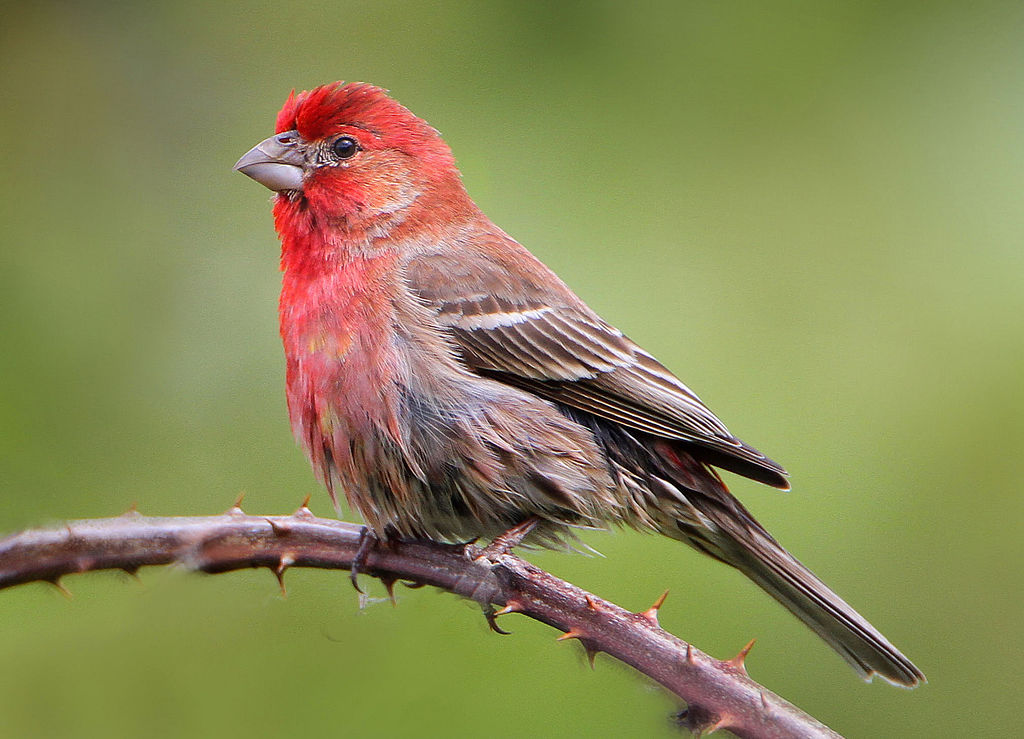
Coloration and Markings: House Finches have gray backs, with short wings sporting row of vertical, black, and white-tipped and edges line, as well as two distinctive white wingbars. They have medium-length, notched gray tails with some white often present on the edges and the belly will be white, with brown or black streaking. Towards the top of the belly, a rosy-red hue fills the plumage nicely up into the breast, as well.
Facially, these birds are rosy-hued with flecks of white, with a gray mask, gray peppered into the plumage at the back and top of the head. These birds have strong, conical gray bills. Females will be gray and brown, with blurry chest streaking and vague-to-little facial marking.
Size: These birds average 5.1 to 5.5 inches in length and have wingspans of 7.9 to 9.8 inches wide.
Diet: Seeds from various weeds make up the majority of the House Finches diet, though in the spring they will also sample fruits and berries. Small insects also supplement their diets from time to time.
More about the House Finch
House Finches are heavily present in Mexico and the western portion of the United States, but they have also been introduced into the eastern U.S. and in the state of Hawaii. Highly adaptable, they seem to do well wherever they go or they’re brought, to the point that these cute little birds are considered by some to be quite invasive!
Woods, grasslands, and even deserts make them feel at home, and like humans they even have regional accents – with distinct variations in song from birds only a mile away! Invasive or no, there little birds are certainly quite the characters.
7. Northern Cardinal – Cardinalis cardinalis
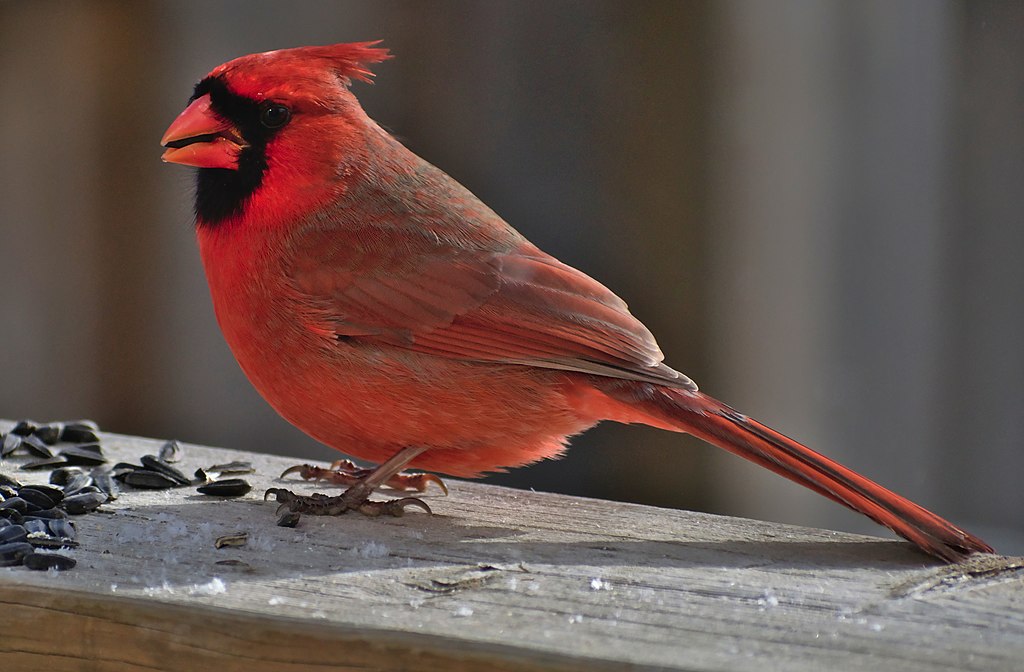
Coloration and Markings: Male Northern Cardinals have striking red backs, with small, red wings which sometimes show bits of gray, and long, red tails. These birds have a red underbelly and breast and facially, they are almost completely red, barring a black mask that covers the eyes and carries down underneath the chin like a large goatee. They have large, brilliant red crests and stout, conical orange bills.
Female Northers Cardinals will be a lovely brown, with splashes of red on the wings, the tail, and in their large, brown crests.
Size: These birds measure in at 8.3 to 9.1 inches in length and have wingspans ranging from 9.8 to 12.2 inches wide.
Diet: Northern Cardinals love fruits and sunflower seeds especially, but they also dine on weed seeds and various grains from time to time.
More about the Northern Cardinal
Northern Cardinals may be found in a lot of places, such as Mexico, Bermuda, Guatemala, and Belize. In the United States, they’re even popular enough to be the state bird for 7 states – Kentucky, Virginia and West Virginia, North Carolina, and Ohio – but you can find them in quite a few of the U.S. states, including some parts of Hawaii! Like many red birds, Northern Cardinals get their vibrant coloring from foods heavy in carotenoids, and they also happen to be the faithful type, as these beautiful birds tend to mate for life.
8. Pileated Woodpecker – Dryocopus pileatus
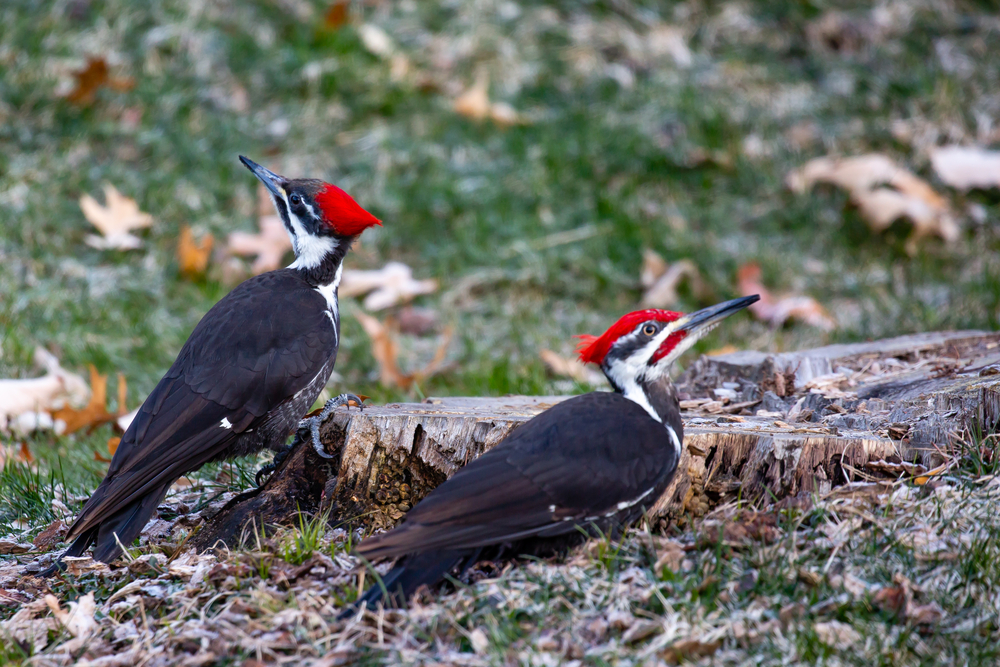
Coloration and Markings: Pileated Woodpeckers have black backs, with long, black wings which are white on 2/3 of the underside. They long, black tails and the underbelly and breast of this bird are black, with a peppering of white coloration sometimes at the underbelly. The black from their chest also extends up into the front of this bird’s throat.
Facially, Pileated Woodpeckers have mostly white faces, with a black mask, a red mustache line, and a mohawk-like triangular crest which is a brilliantly red and impossible to miss! These birds have long, straight black bills, which often have a bit of white present on the lower bill.
Size: These woodpeckers are large, measuring 15.8 to 19.3 inches in length and with wingspans of 26 to 29.5 inches wide.
Diet: Pileated Woodpeckers eat a lot of ants – especially carpenter ants – but also dine on caterpillars, termites, beetle larvae, and even cockroaches. They also have a sweet tooth, eating berries and nuts when they find them and occasionally sampling sugar water from backyard feeders.
More about the Pileated Woodpecker
Found in Canada, the Pacific coast, and in the Eastern United States, Pileated Woodpeckers are big, beautiful, and hard to miss! These woodpeckers love eating ants, too, and burrow rectangular holes to get them that are deep enough to break smaller trees.
That excavation also attracts the attention of other bids, such as House Wrens and different species of Woodpeckers, who flock nearby and wait for the Pileated Woodpecker to leave so that they can see how many ants they have missed!
9. Pine Grosbeak – Pinicola enucleator

Coloration and Markings: Pine Grosbeaks have red backs, with little flecks and sometimes large patches of gray present, along with small, gray wings with white edging present. They have long, lightly notched gray tails, and gray underbellies with red breasts which are also gray-flanked.
Facially, these birds are red, with a gray mask and a conical, often stubby dark gray to black bill. Females and juveniles will be mostly gray, with touches of yellow, red, and orange to their plumage.
Size: These Grosbeaks measure 7.9 to 9.8 inches in length and have wingspans approximately 13 inches wide.
Diet: Maple buds, conifer and weed seeds, and wild fruits and berries make up the lion’s share of the Pine Grosbeaks diet, though small insects definitely become part of the menu when it’s warm out.
More about the Pine Grosbeak
Found in the coastal rainforest regions of Alaska, as well as in the western United States, Canada, and British Columbia, Pine Grosbeaks are technically finches. They share this with Eastern Grosbeaks, while other Grosbeaks are actually part of the Cardinal family.
While they dine largely on vegetable matter, this is a bit too hard for their chicks to digest, so they are fed a mix of insects and partially digested vegetable matter for a ‘lighter’ meal.
That said, when they find fruit they really seem to like it – Grosbeak flock are well-known for camping in fruit trees and hanging around until all of the fruits are gone!
10. Purple Finch – Haemorhous purpureus
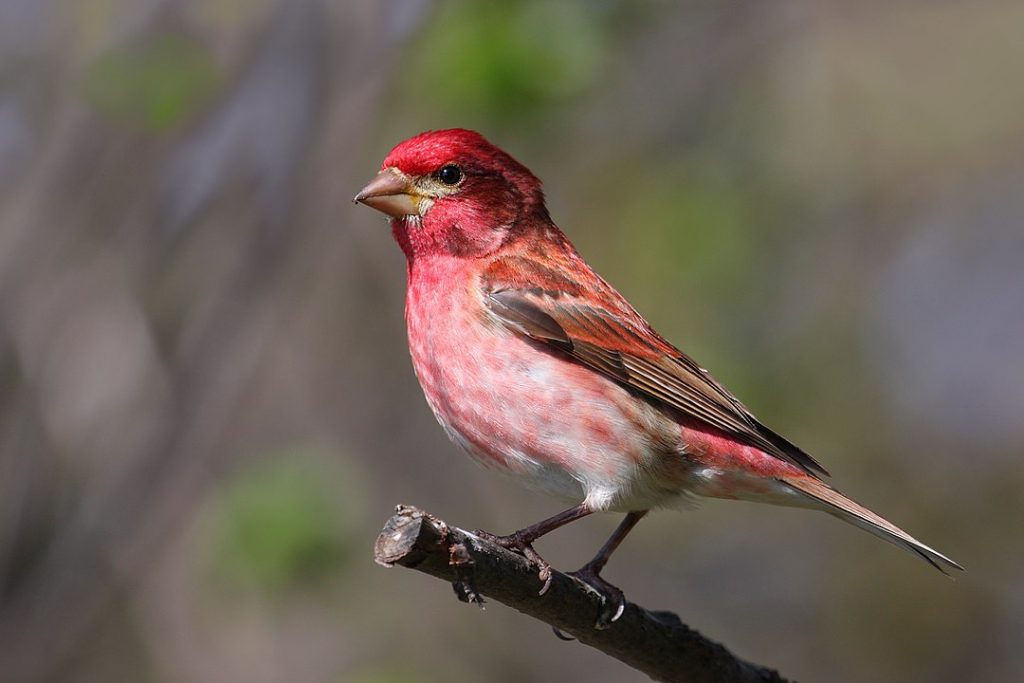
Coloration and Markings: Purple Finches have brownish-red backs, with short brown and red wings which have white edging, as well as two thin wingbars each. They have medium length reddish-brown tails and the underbelly and breast of this bird are white, with streaking of rosy red starting lightly from the belly and thickening noticeably as it approaches the breast.
Facially, these birds are pinkish-red with lighter-colored eyelines, mustache lines, and throat and have stout, conical, pinkish-gray bills. Females will have coarser streaking, but will exhibit no traces of the male’s red coloration.
Size: These Finches measure 4.7 to 6.3 inches long and have wingspans of 8.7 to 10.2 inches wide.
Diet: Ash, Elm, weed, and grass seeds are all favorites of the Purple Finch, though berries, buds, and bugs are on the menu in the warmer months as well.
More about the Purple Finch
Found throughout the United States (barring the western bits), as well as Canadaand the Pacific Coast, the Purple Finch is quite the prolific bird, with its worldwide population being estimated at about 6.4 million birds. They also just happen to be the state bird of New Hampshire!
While they certainly have lovely plumage, this can come with a downside, as they are commonly preyed upon by American Kestrels, Barn Owls, and Blue Jays, and while they are being chased, their nests are occasionally raid for eggs by opportunistic Grackles and squirrels.
Thankfully, they produce about 3 to 6 eggs at a time, so between this and their appreciable adaptability, Purple Finches should not be going away anytime soon.
11. Pyrrhuloxia – Cardinalis sinuatus
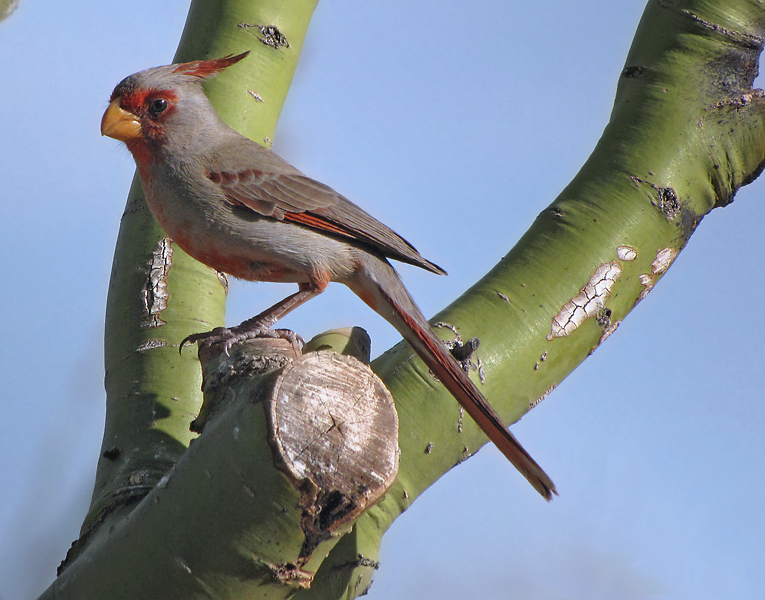
Coloration and Markings: Pyrrhuloxia have gray backs, with small, gray wings that have a splash of red, and long, gray tails with red edging and red undersides, which are white tipped. The underbelly and breast of this bird are gray as well, with a heavy splash or red coloration, and facially these birds have red around the eyes, bill, throat, and the tip of the crest, though the face will largely be gray.
These birds have short, but powerful conical-shaped yellow bills and females will be more of a buffy-gray overall, with only trace elements of red coloration.
Size: These birds have a mature length of approximately 8.3 inches and a wingspan approximately 12 inches wide.
Diet: Insects are a big part of the Pyrrhuloxia’s diet and they will gobble up caterpillars, beetles, and grasshoppers with delight. They also happen to love mesquite and other seeds, as well as various fruits (with cactus fruit being another favorite on their menu).
More about the Pyrrhuloxia
Also known as the ‘Desert Cardinal’, the Pyrrhuloxia is found in northern Mexico and across the American Southwest. If this bird looks a little familiar to you, then you are not alone. The ‘Desert Cardinal’ appellation really fits, as this bird looks like a yellow-billed Cardinal that’s been playing in thick, gray ash.
The name Pyrrhuloxia, incidentally, basically translates out to ‘flame-colored and crooked’, in reference to the bird’s plumage and to it’s powerful, but crooked bill. While they are suited for desert environs, it’s noteworthy that you will sometimes catch this bird near human settlements where there’s a bit of cold air leaking out on the patio.
If you see one on yours, be sure to take a picture and share!
12. Red Crossbill – Loxia curvirostra

Coloration and Markings: The Red Crossbill is a hard bird to miss, with it’s back the reddish-orange of brick and it’s small-to-medium length gray wings. These Crossbills also have a short, gray tail which is lighter colored on the underside in grays and whites, and gray coloration on the rump. The underbelly and breast of this bird are brick-red as well.
Facially, these birds are brick-red with some gray around the eyes and curving vertically around the ear and they have stout, medium-length bills with a noticeable curve. Females and juveniles will be olive colored or even a smooth brown.
Size: These birds measure in at 5.5 to 7.5 inches in length and have wingspans of 10 to 11 inches wide.
Diet: Red Crossbill love seeds especially from various type of pine cones which their bills are perfect for cracking and consuming. Small insets are also on the menu, especially ants, coneworms, and the occasional unlucky spider.
More about the Red Crossbill
One of the biggest finches you’ll see while birding, Red Crossbills may be found throughout North America, as well as Europe and in Asia. Those ‘crossed bills’ come in handy, as well, as these birds are particular fond of conifer seeds, to the point that any heavily-laden conifer is an invitation for Red Crossbills to build a nest and to fill it!
Said bills start off straight, as well, obtaining their characteristic curve at approximate 4 to 5 weeks of age. As the babies are eating conifer seeds too, that beak development is simply yet another sensible choice dictated by Mother Nature.
13. Red-Bellied Woodpecker – Melanerpes carolinus

Coloration and Markings: Red-Bellied Woodpeckers are a common, but favorite sighting with many birders, and the first thing you notice is their black and white zebra-striped backs. They also have long, black and white striped wings, and stout, split black tails and the underbelly and breast of this bird are white, with delightful splashes of red throughout.
Facially, these Woodpeckers have white faces, with splashes of red on the face under the eyes and sometimes at the throat, and brilliant red caps that you can easily see from a long distance. These birds have long, straight black bills.
Size: These Woodpeckers have an overall length of around 9.4 inches and sport wingspans between 13 and 16.5 inches wide.
Diet: Red-Bellied Woodpeckers are omnivorous, eating insects, fruits, nuts, as well as tree sap and sugar water from the occasional backyard feeder.
More about the Red-Bellied Woodpecker
You can find the Red-Bellied Woodpecker in Canada, as well as the Eastern United States, where they are sometimes even spotted in Florida. These opportunistic feeders can be interesting to watch when it’s time for a snack.
If large prey is captured, they will simply dash it against the tree to make it more manageable for consumption, and they have long, sticky tongues to better get at tree sap when they feel like washing it down with something sweet.
While their bright coloration makes them quite noticeable, they are mostly only preyed on by hawks and determined kitty-cats, though the Woodpecker often chooses to harass these predators, rather than hide from them – a fairly effective strategy for these medium-size Woodpeckers.
14. Red-Breasted Sapsucker – Sphyrapicus ruber

Coloration and Markings: Red-Breasted Sapsuckers have white-spotted, black backs, with long, black wings that bear a little white spotting and a large white patch towards the outer edge. They have long, black tails, which are black and white down the center at the rump and the underbelly and breast of this bird are white with heavy black streaking. Towards the top of the breast you will see a large ‘v’ of red, as well, coming down from the throat.
Facially, these birds are a deep red, with a black mark often present at the cheek and a thin, white eyeline that you can see if the bird is very close. These birds have long, straight black bills.
Size: These Woodpeckers measure in at 7.9 to 8.7 inches long and have wingspans of 14.6 to 16 inches wide.
Diet: Red-Bellied Sapsuckers eat lots of ants and other small insects, as well as tree sap and the occasional small fruits.
More about the Red-Breasted Sapsucker
Found in western North America and the Pacific coast, Red-Breasted Sapsuckers are certified lovers of deciduous woodlands, where they’ll target trees like aspens for sap-mining and for making nests. If you have a maple tree in your backyard, then you might get a visit, and Hummingbirds might also make an appearance.
The little Hummingbirds like to make use of the sap-wells that the Red-Breasted Sapsucker drills and take advantage of them to stave off hunger until things get warm and flowery outside.
15. Red-faced Warbler – Cardellina rubrifrons

Coloration and Markings: Red-Faced Warblers have smooth, gray backs, with small, dark gray, and lightly white-edged wings, as well as long, gray tails which are visibly notched. The underbelly and breast of this bird are a ‘dirty white’ mix of white and gray and facially, these birds are tri-colored – with gray at the back of the head, black at the center coming from the top of the head and settling below the cheek, while the rest of the face is a vibrant red.
These birds have straight, medium-length, and sharp gray bills and females will have a much duller red, while juveniles will have a bit of pink to their faces.
Size: These Warblers measure in at approximately 5.5 inches long and have wingspans averaging 8.3 inches wide, when fully mature.
Diet: While they will eat seeds and small fruits when the pickings are thin, these birds prefer a heavy diet of small insects whenever they are available.
More about the Red-Faced Warbler
Red-Faced Warblers hang their little hats in New Mexico, Arizona, and in Mexico, as well. While they prefer mountains and canyons (especially with a stream nearby), they do make their way down to forested areas and the occasional backyard.
An interesting fact about these cute little birds is that they keep their red longer during the year than most. This is because they will only molt their feathers once yearly, while most species will do it twice. As such, these little guys and gals stay colorful throughout the year.
16. Red-headed Finch – Amadina erythrocephala

Coloration and Markings: The Red-Headed Finch has a smooth, gray back, with medium-length gray wings that bear two black and white striped wingbars on each. They have long, gray tails, and the belly and breast of this birds are striped black and white in a lovely ‘Zebra’ type pattern.
Facially, these birds are red, with a little gray at the eye and a gray patch at the cheek. These birds have short, stout, and conical gray bills. Females will be mostly gray and brown.
Size: These birds measure in at 6 to 7 inches long, with wingspans of 8 up to 10 inches wide.
Diet: Red-Headed Finches enjoy a diet of grains, plant buds, seeds, and small fruits. When available, they’ll also supplement their diet with small insects, such as worms and crickets.
More about the Red-Headed Finch
While there are reported North American sightings, the Red-Headed Finch is more likely to be spotted outside of the country – occurring most commonly in Zimbabwe and parts of Southern Africa. Hardy birds, Red-Headed Finches can do well, even in the Kalahari Desert, although they are often preyed upon by hawks and even vultures!
Thankfully, these birds understand that there is power in numbers, and the monogamous Red-Headed Finch takes advantage of this with communal nesting grounds where the flock can number 200 to 300 birds.
Even Finches know, it’s good to have friends!
17. Red-Headed Woodpecker – Melanerpes erythrocephalus
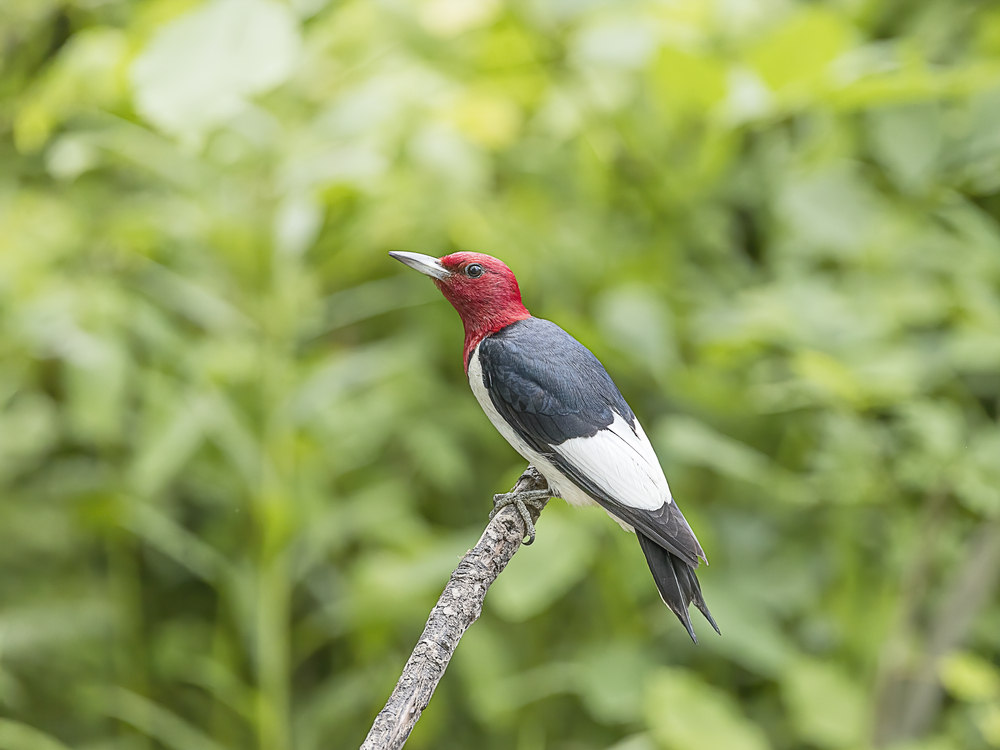
Coloration and Markings: Red-Headed Woodpeckers have black backs, with long, black wings that bear a large, white patch on each, and small, notched black tails which are white on the undersides. The underbelly and breast of these Woodpeckers is a snowy white and facially, these birds are a shiny crimson red.
These birds have long, straight black bills, and juveniles won’t have their red yet, but instead display grayish-brown heads until they mature.
Size: These birds measure in at 7.5 to 9.1 inches in length and have wingspans approximately 16.5 inches wide when fully grown.
Diet: The opportunistic Red-Headed Woodpecker eats just about anything, with insects, rodents, fruits and berries, corn, and even poison ivy fruits being all considered a fine meal by these birds.
More about the Red-Headed Woodpecker
You can find the Red-Headed Woodpecker in southern Canada, as well as the eastern and central parts of the United States. While these Woodpeckers are actually quite skillful flycatchers, insects will really only make up about 1/3 of their diet, as they really favor seeds and tasty options such as fruits and nuts.
They are also the only North American Woodpecker to not only hide, but to also COVER their food. They will store long-lasting foods like nuts directly into trees, and then further secure their cache by stuffing in broken wood bits or convenient bark.
18. Scarlet Flycatcher – Pyrocephalus rubinus

Coloration and Markings: Scarlet Flycatchers have brownish-black backs, with long wings and tails of the same color. The underbelly and breast of this bird are a bright orange or red, and facially these birds are red with a dark brownish-black mask that extends to the back of the neck. These birds have short, pointy, brownish-black bills.
Females and juveniles will be brownish gray, with splashes of pink on the underbelly and breast.
Size: These birds measure in at 4.8 to 5.4 inches long and have a wingspan of 9.4 to 9.8 inches wide.
Diet: Scarlet Flycatchers do eat a lot of flies, as the name suggests, though just about any flying insect is game – including the occasional surprised bee! They will also grab small fish if they see them, though this is certainly uncommon and quite the lucky sighting!
More about the Scarlet Flycatcher
Found in the southwestern United states, as well as Central and South America, along with Canada, Scarlet Flycatchers are quite the little wanderers. They are well-suited for coastal lowlands and deserts alike, being quite adaptable in their hunt for food, so be sure to keep an eye out for these colorful little guys and gals if you happen to be in one of their territories.
Also called ‘Vermillion Flycatchers’, a fun little fact about these birds is that when they come courting, they tend to bring gifts – with butterflies being a popular gift when seeking the attentions of a female!
19. Scarlet Tanager – Piranga olivacea
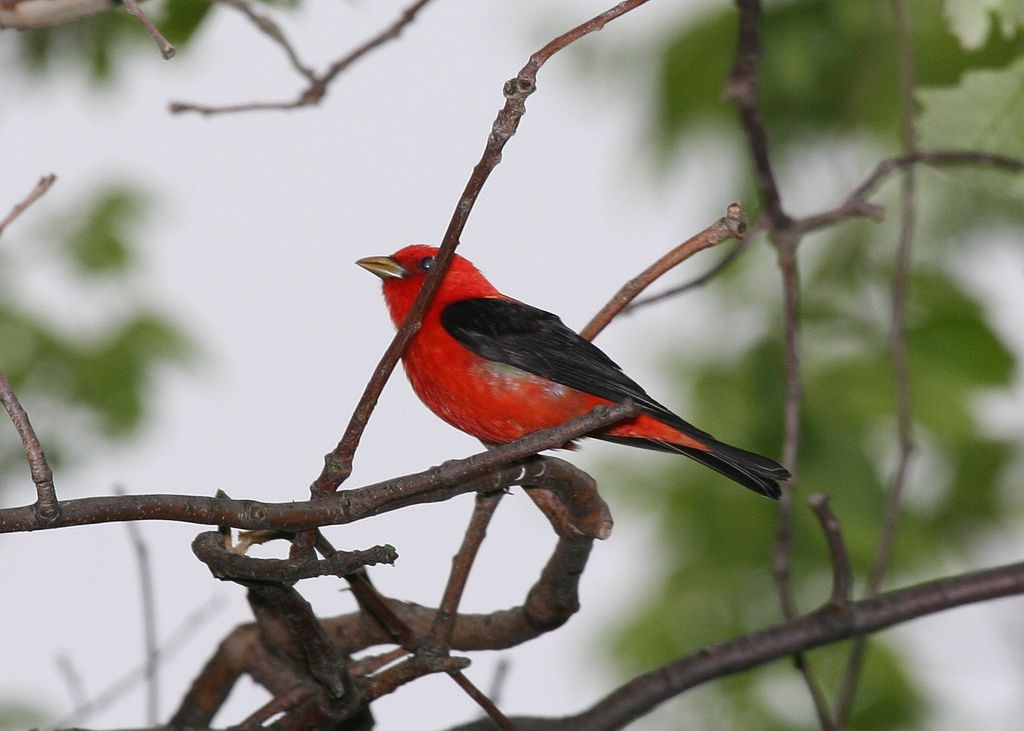
Coloration and Markings: Scarlet Tanagers are bright red all over, with the exception of their small, black wings and their tiny black tails. The wings will sometimes sport a spot of yellow, but this is not always guaranteed, and that wild coloration will only occur for them males in the spring and summer months.
Female and juvenile Scarlets will be a yellowish-olive color overall and males will look a bit like females when it’s not breeding season, switching to the same olive colors with the exception of their telltale black wings.
Size: These birds measure in at 6.3 to 6.7 inches in length and have wingspans of 9.8 to 11.4 inches wide.
Diet: Caterpillars, moths, beetles, and other small insects make up most of the Scarlet Tanager’s diet, although berries and small fruits are also considered.
More about the Scarlet Tanager
Scarlet Tanagers may be found in the eastern portions of North America, as well as western South America. While these birds are active during the day, you’ll want to look for look for them up high – as these birds tend to hide out in the branches of tall trees while foraging.
Scarlet Tanagers just happen to be monogamous and they are also favorite targets of the infamous Cowbird. Unlike many species, however, these birds know what’s up – immediately attacking and driving away sneaky Cowbirds on sight whenever they can.
Cowbirds are good at what they do, however, and if they manage to hide an egg in the current clutch then the Scarlet Tanager will not notice the difference.
20. Summer Tanager – Piranga rubra
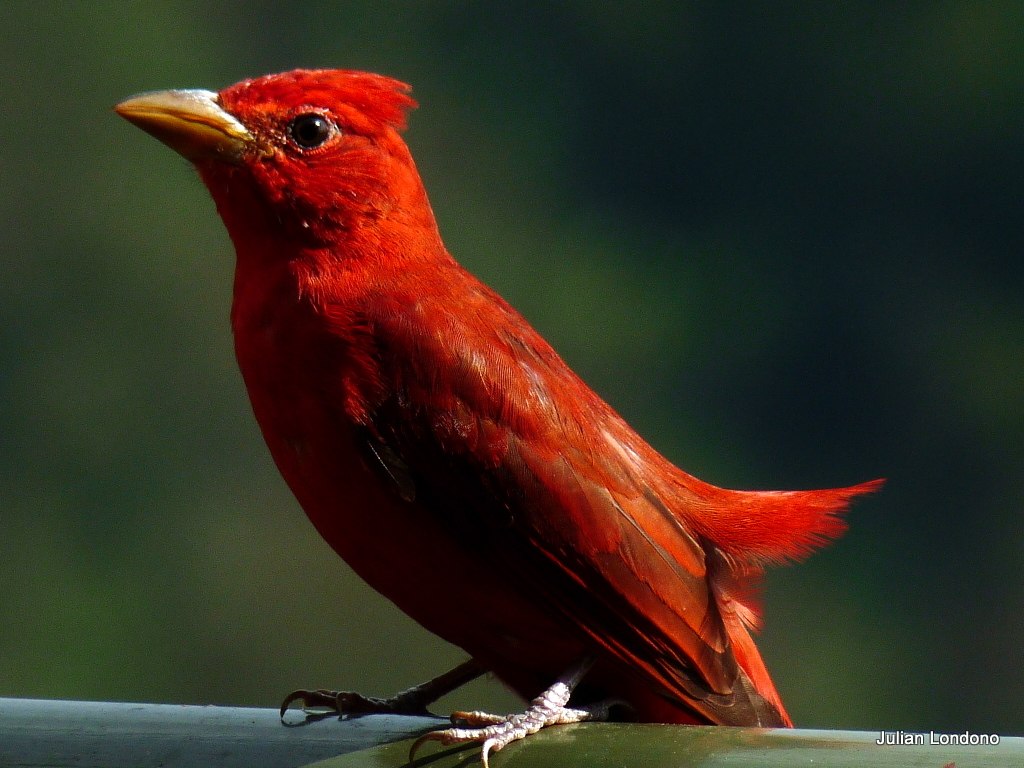
Coloration and Markings: The Summer Tanager wins our award for this article’s ‘easiest bird to describe’. Males will be completely bright red all over, with small wings and perky, medium-length and notched tails. When molting, the males will sometimes be yellow and red in patches, and females and juveniles will be greenish yellow with bright yellow heads.
These birds have thick, pale, conical shape bills.
Size: These birds average about 6.7 inches from tip to tail and wingspans approximately 11 to 12 inches wide.
Diet: Insects and fruits are the favored snacks for the Summer Tanager and if you have one nearby then you’ll be happy to know that they also love to eat wasps and bees!
More about the Summer Tanager
Found in southern United States and as far north as Iowa, Summer Tanagers also spend a good bit of time in northern Mexico and Central and South America. These lovely birds have the honor of being the only completely red bird in the whole of North America but that color certainly comes with its own caveats, as they are preyed upon by Hawks, Jays, Owls, snakes, and squirrels.
If you happen to spot a Summer Tanager catching a wasp or a bee, then watch closely so that you can see how they do it. The clever birds will rub the insect’s stinger against something sturdy, suck as tree bark, to remove it for safe consumption of their buzzing, panicked snack!
21. Western Tanager – Piranga ludoviciana
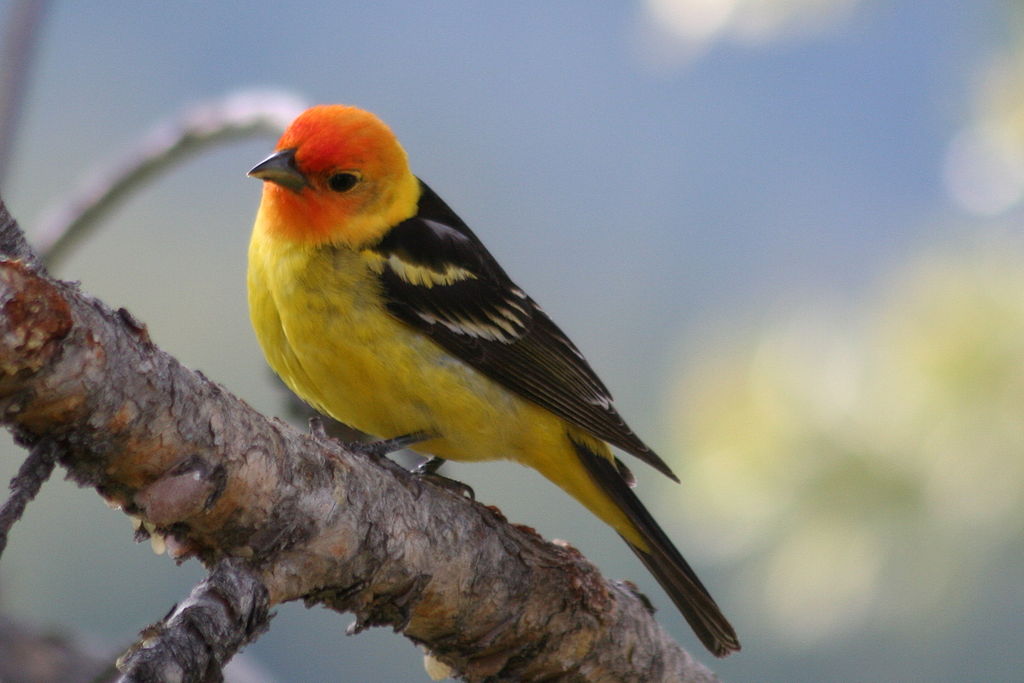
Coloration and Markings: Western Tanagers are a collage of colors, with backs which are black on top and yellow on the lower half, along with medium-length black wings that sport a yellow wingbar on top and a white one below. They have medium-length black tails and they are yellow on the underside, from rump to breast.
Facially, these birds are a ‘flame’ mix of mostly yellow with splotches of blood red and they have short, sharp, conical bills which are dark gray to black in color. Female Western Tanagers tend to be more of a lime and yellow hue, with red on the front of the face, and juveniles will have a little red on their head in the spring, though none in the fall.
Size: These birds are approximately 6.3 to 7.5 inches long, when measured from tip to tail, and they have wingspans averaging 11.5 inches wide.
Diet: Western Tanagers eat a number of different insects, such as ants, wasps, grasshoppers, and even termites. Aside from this, fruits and berries are also welcome, though they are not very fond of seeds, eating them only out of necessity.
More about the Western Tanager
Found in Canada, as well as North and Central America, the Western Tanager is an amazing sight. With the yellow and red of the male’s plumage, these little birds are the color of flame, and you’ll want to take a look at their wings when you spot one. Not many birds have more than one wingbar color, but the Western Tanager sports one that is yellow and another below that is white!
Like other birds, Western Tanagers get those vibrant colors from their foods, but their particular coloration doesn’t come from carotenoids, like it does with many red-plumage birds, but rather a chemical known as rhodoxanthin.
While we know the chemical, we can’t be 100% certain of the source, but we believe that they are most likely getting it from some of the insects in their diet.
Some Closing Words on Red Headed Birds
That’s all of the space that we have for today, but we hope that you have enjoyed this humble list of redheaded birds. As you can see, you’ve got a lot of species to watch for, so be sure to plan ahead this year and see how many of these lovelies that you can spot. Just be sure to keep a camera or your trusty cellphone handy, just in case you need to snap a picture.
You’ll need it… because beauty like that is simply too good for words. Until next time, happy birding, and we wish you the very best!